De Anza trained lifeguards volunteered at the Silicon Valley Kids Triathlon, June 6, 2004. There were 550 athletes registered for the race. They swam in age groups; oldest were 13 to 14, youngest were 6 and under.
Each wave start first gathered in the bleachers, then went down to the pool. Some hopped along the way, a few younger girls held each others’ hands.
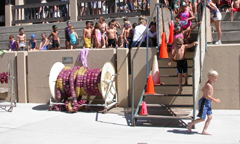
Triathletes often have their race numbers on their upper arms and their age on their calves. Two of these triathletes had the number 3 on their lower legs.

At this triathlon each group waits sitting at the pool edge,
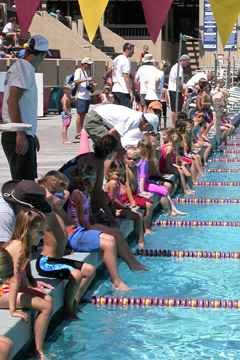


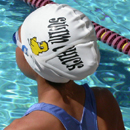
then gets into the pool with about a minute left before the start.
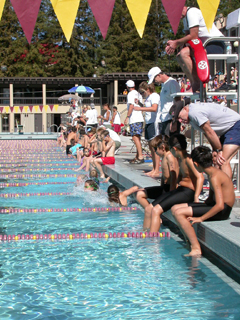
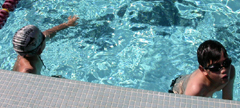
The crowd often counts down the last seconds with the announcer: ten…nine…eight…seven…six…five…four…three…two…one…
an airhorn sounds and the kids are off.
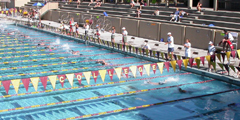
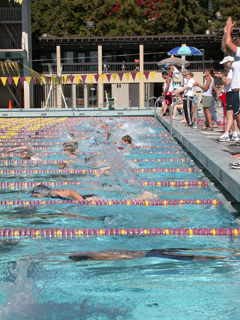
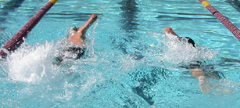
Many swimmers have great strokes and flip turns. Most used freestyle, some swam breaststroke and some swam only on their back. Some use variations of a determined doggie paddle. Some get across the pool by holding on to a kickboard and kicking while pulling on a laneline.

Many of the youngest swimmers were assisted by lifeguards swimming next to or near them.

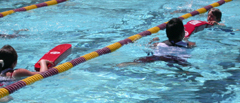
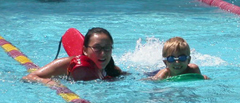
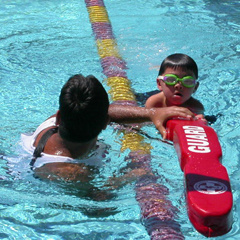

The De Anza trained lifeguards (some of whom are lifeguard instructors = LGI) at this event were Alan Ahlstrand (LGI), Gong Chen, Veronica Moreno, Duong Nguyen (LGI), Jennifer Oldham, Mike Rivers (LGI), Wendy Sato (LGI), Christine Schuhe (LGI), Shahin Zonoobi and the De Anza lifeguard instructor and lifeguard instructor trainer, Mary Donahue.
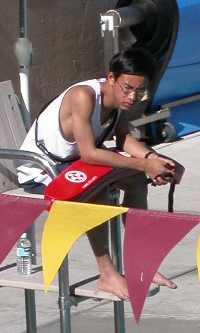
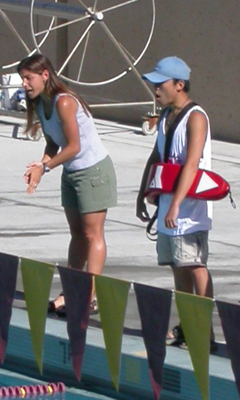
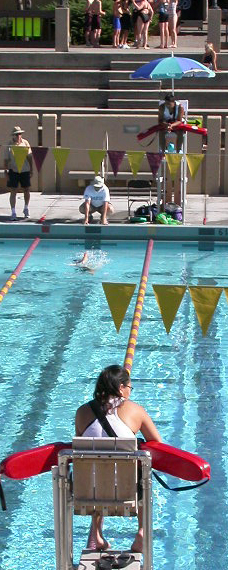
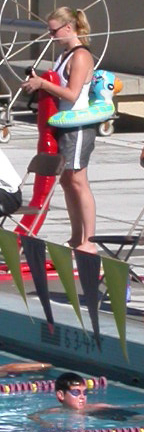


Why/when do the lifeguards get into the pool?
In the first case this year, a girl swam to a lane line and raised her hand, the prearranged signal that she wanted help. As I swam up to her I said “if I swim next to you the whole way could you finish the swim?” She agreed and we finished her second 50 together with my rescue tube where she could easily grab it if needed.
Many of the kids had competitor-class strokes. If it had been a recreational swim instead of a race, we would have pulled kids whose strokes were weak and told them they should not be trying to swim such a great distance. But as it was a race, if their faces/eyes/actions looked determined rather than scared, if they were getting air and not coughing and especially important, if they kept a somewhat effective kick and their legs did not sink, we let them all complete the swim.
Alan jumped in as he watched a doggie paddler go from swimmer to distressed victim to active drowning victim in five seconds. The boy was paddling well, then stopped kicking and his legs sank. Finally he was dog paddling vertically, not making any forward progress and unable to reach the laneline only inches away. The young man in question, the parents and spectators might not have known he needed help, but a trained lifeguard does.
13 thru 14 year olds start first and swim 200 yards, bike 6 miles, run 1.25 miles
11 thru 12 swim 200 yards, bike 6 miles, run 1.25 miles
9 thru 10 swim 100 yards, bike 4 miles, run 0.50 mile
7 thru 8 swim 100 yards, bike 2 miles, run 0.50 mile
6 and under start last and swim 25 yards, bike 1 mile, run 0.25 mile
According to the race website:
“The net proceeds from this triathlon will benefit Silicon Valley Children’s Fund (www.svcf.org). SVCF is a 501(c)(3) dedicated to developing and supporting special programs, projects and services to help and heal the abused, neglected and at-risk youth at the Children’s Shelter of Santa Clara County and the community. SVCF puts “Kids First” and serves as a catalyst for engaging community awareness and action to prevent child abuse and enhance the quality of life for all youth.”
We were told at the end of the race that it may have earned $12,000 to $14,000 for these charities.
see also: guarding the Silicon Valley Kids’ Triathlon 2005
guarding the Silicon Valley Kid’s Triathlon 2007
volunteer lifeguards at the Silcon Valley Kids’ Triathlon 2009